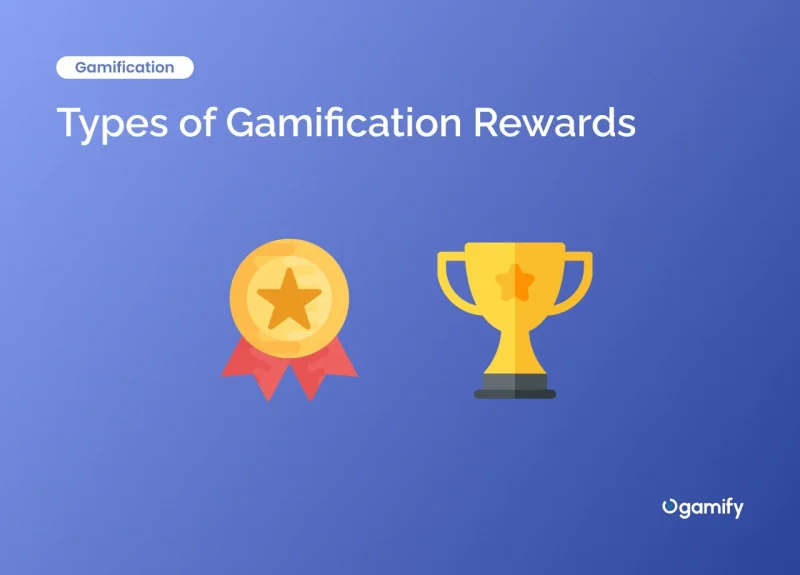Gamification techniques has gained significant traction as an innovative approach to engage and motivate individuals, whether in the workplace, educational settings, or various organizations. At the heart of any successful gamification system lie rewards, which serve as powerful incentives and recognition for desired actions and achievements. Different reward structures can effectively cater to diverse preferences and drive various behaviours, ultimately fostering continued engagement and progress.
A well-designed gamification rewards program incorporates various types of reward systems in the organization, ensuring that all participants find motivation and satisfaction in their accomplishments. These rewards can range from recognition for good performance and uplifting privileges to tangible incentives. Organizational leaders can leverage these rewards in the workplace to improve employee engagement, productivity, and satisfaction.
This article will explore six distinct types of gamification rewards – shedding light on their unique benefits, how they can be effectively implemented, and ultimately, how they contribute to creating successful and engaging gamification experiences.
What are Gamification Rewards?

Gamification rewards are an integral aspect of gamification systems, primarily employed to enhance workplace motivation and cultivate a thriving workplace culture. These rewards programs serve as incentives to engage employees in desired behaviours, thereby fostering a sense of achievement and recognition.
In gamification, rewards are designed to be both tangible and intangible, catering to diverse preferences and personality traits. While tangible rewards include monetary bonuses, gift cards, or physical items, virtual rewards encompass virtual badges, leaderboard rankings, or exclusive access to premium features or challenges. One effective strategy is incorporating a dedicated store feature within your gamification system, where participants can access and redeem enticing incentives.
These rewards instil a sense of purpose as employees strive to unlock new achievements and reach higher performance levels. Moreover, the use of unconventional terminologies, such as “sparkling milestones” or “illustrious tokens of triumph,” adds a touch of novelty and intrigue to the rewards, amplifying their allure and impact.
Gamification Rewards Types and Examples

Fixed Action Rewards
Fixed action rewards within a workplace gamification system are designed to be specific and straightforward, providing users with clear instructions on earning their rewards. This approach ensures that participants know exactly what actions they need to take in order to receive the desired rewards. Such rewards are often part of a comprehensive gamification rewards program, which aims to enhance employee engagement and motivation.
The sudden rewards offered in this program can include points, badges, or other incentives that are directly linked to predefined actions within the system. For example, employees may earn points for completing their daily tasks or achieving specific sales targets. By aligning the gamification reward system with well-defined actions, organizations can effectively motivate their employees and drive desired behaviors, ultimately contributing to overall productivity and success.
Randomized Rewards for Enhanced Engagement
Random rewards introduce an element of surprise and excitement into a workplace gamification system. Instead of following a predictable pattern, these unexpected rewards are given out at unexpected times or for activities that do not have a predetermined reward attached to them. By incorporating this element of unpredictability, participants are motivated to actively engage with the system, as they never know when they might receive a reward. This can create a sense of accomplishment and anticipation, increasing engagement and participation.
Examples of randomized rewards within a gamification rewards and recognition program include entering users into a draw for a valuable prize after completing specific tasks or offering bonuses to employees who surpass performance expectations. By infusing the gamification reward system with randomness, organizations can stimulate employees’ curiosity and maintain their interest in the gamification program, ultimately boosting motivation and performance.
Competitive Rewards for Recognition and Achievement
Competitive rewards within a workplace gamification system tap into individuals’ innate desire for competition and social recognition. By incorporating elements such as leaderboards, point systems, or virtual trophies, organizations can foster a sense of accomplishment and camaraderie among participants. These rewards showcase users’ relative success compared to others, driving healthy competition and encouraging individuals to strive for excellence.
For instance, a workplace gamification initiative might highlight top performers with special recognition or grant them access to exclusive privileges.
Cooperative Rewards for Teamwork and Collaboration

Cooperative rewards within a gamification system emphasize the importance of teamwork and collaboration in the workplace. Organizations can foster a sense of unity and belonging among participants by incentivising users to work together towards a common goal. These rewards reinforce positive aspects of workplace culture, promoting collaboration and fostering strong team dynamics.
Examples of cooperative rewards within a gamification rewards program include team-based bonuses or recognition for collaborative problem-solving and idea generation. By encouraging employees to collaborate and support each other, organizations can create a cooperative and productive work environment, enhancing creativity, innovation, and overall success.
Status-Based Rewards for Social Standing and Pride
Status-based rewards in a workplace gamification system allow users to increase their social standing and access additional privileges or resources. As participants progress through the gamification platform, they can unlock badges, titles, or exclusive benefits that symbolize their accomplishments and elevate their position within the group.
This type of reward plays a significant role in workplace motivation, as it appeals to individuals’ desire for recognition and personal fulfillment. By providing employees with status-based rewards, organizations can instill a sense of pride and achievement, driving them to excel and contribute to the company’s overall success. These rewards also promote healthy competition and visually represent an individual’s progress within the gamification system.
Role-Based Rewards for Expertise and Contribution
Role-based rewards within a gamification system assign specific roles or responsibilities to users based on their actions or achievements. This approach recognizes and rewards individuals demonstrating expertise or making meaningful contributions within the gamification system. By offering role-based rewards, organizations offer participants unique and exclusive opportunities to showcase their skills and knowledge, for example, on ValueFeed. For example, top performers may be allowed to become mentors or trainers for their peers who are new to the gamification system.
This role-based reward recognises their achievements and allows them to contribute to the development and growth of others. By leveraging the expertise of these individuals, organizations can create a supportive learning environment and foster continuous improvement among participants. Role-based rewards motivate employees to excel and promote a culture of knowledge-sharing and collaboration, ultimately benefiting the entire organization.
By leveraging a variety of gamification rewards, organizations can create engaging and diverse experiences that foster motivation, productivity, and collaboration. Whether implemented within a workplace setting or a leisure industry application, these reward systems offer versatile opportunities for enhancing user experiences and driving performance improvements through positive reinforcement and recognition
Conclusion

Implementing a well-designed gamification rewards program can significantly enhance workplace motivation and productivity, leading to a positive workplace culture. The different types of reward systems, such as fixed action, random, and recognition-based rewards, cater to various employee preferences and behaviours, ensuring that every individual is acknowledged for their contributions.
It is essential to carefully consider the types of reward for good performance that your organisation offers, as these can significantly impact staff morale and performance. By understanding and catering to the unique needs of the workplace, a company can foster an environment that promotes growth and collaboration.
Integrating chat platforms and other interactive tools can further elevate the gamification experience, promoting real-time communication, feedback, and meaningful recognition. This enhances the overall effectiveness of the rewards system, as employees feel more connected and valued within the organization.
Applying the right types of reward systems in the workplace can increase employee satisfaction, retention, and overall success for the organization. Any business can create a thriving and supportive environment that drives continuous growth and success by using gamification and investing in employee recognition.


